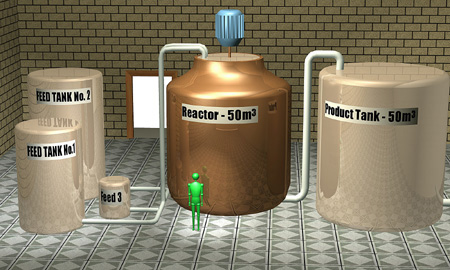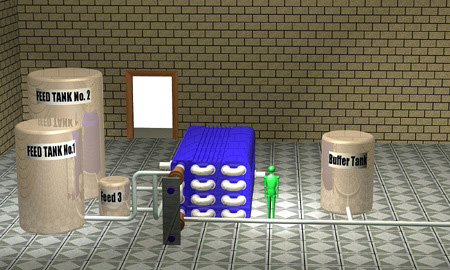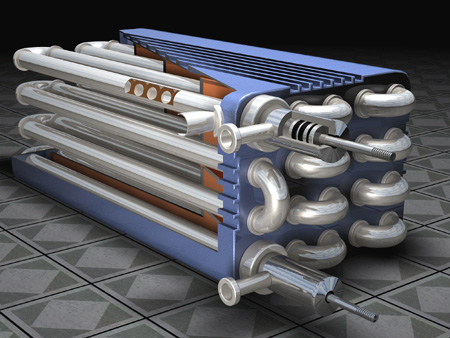There is potential for OFM to be employed as a compact and efficient tubular reactor. We are now investigating the viability of an oscillatory flow reactor for Process Intensification of batch processes requiring long residence times, for which continuous processing is generally considered unsuitable. Our work seeks to exploit the ability for the oscillatory flow reactor to improve both conversion and selectivity by improved liquid-liquid mixing, residence time characteristics and thermal control. We therefore hope to achieve process intensification by improved chemical performance, as well as by substantial reduction in reactor size requirements.
The Figures 1 and 2 below show how a batch process might converted to continuous operation using OFM. In an OFM reactor, inter-baffle zone behaves as a unit stirred tank, so mixing over the length of the tube is the cumulative effect of all the discrete mixing units. The reactor geometry shown in the example incorporates 60 discrete mixing units, meaning that tube would be a close approximation to a plug flow reactor. Total reactor volume would be minimised: for example, if the batch cycle required only 10% of its time for reaction, then the volume for a continuous OFM reactor would be a factor of ten less for the same equivalent production rate. Furthermore, because mixing (and therefore RTD) is controlled by the oscillation, Process Intensification of a batch process could be achieved in a tubular reactors of long residence times (of order hours) without resorting high tube velocities normally associated with these reactors.
 |
| Figure 1. Schmatic diagram of current technology using batch processing. |
 |
|
Figure 2. Schmatic diagram of process intensification with new OFM technology. |
The most suitable applications are likely to be speciality chemicals production requiring long reaction times (hours), and production rates of the order 1-5 t/hr.
Some likely advantages of PI using reactor based on OFM
The unique features of a continuous reactor based on OFM would be:
-
Highly compact, continuous, parallel tube reactor configuration;
- Versatile multi-tube configurations, i.e. thermal profiling and multiple feed/product side streams;
- Smaller L/d than other "once through" tubular reactors;
- Fine control over mixing, temperature profiles, RTD, solids suspension and size distribution, all independently of throughput.
By handling smaller volumes than the alternative batch reactor, OFM would represent significant improvements in process safety, especially for exothermic reactions. In addition, the higher selectivity and continuous operation mode supported by a reactor based on OFM would represent significant reductions in man-power and waste generation between batches, consequently resulting in higher sustainability of industrial processes with significantly reduced operational costs.
Industrial-scale Oscillatory Flow Reactor
Figure 3 shows a cutaway view of a concept design for a 20-pass, 500 litre industrial scale Oscillatory Flow Reactor (OFR), capable of a continuous production rate of 2 tons/hr (assuming a 15min mean residence time). The design is based on a 100mm tube diameter fitted with standard orifice baffles (hole diameter 50mm) spaced at 150mm. Each tube is approx 3.5m long. The reactor is heated by a fluid filled outer shell, fitted with internal baffling to promote efficient fluid flow through the shell. Fluid oscillation could be provided by servo-hydraulic actuators, which would be attached to the piston rods (shown in the diagram above).
 |
|
Figure 3. Diagram of an industrial-scale Oscillatory Flow Reactor. |

